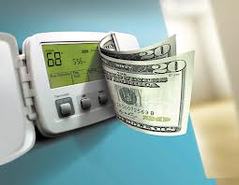
Although there’s not much that can be done to lower the price of natural gas this winter, here are fast and free things you can do to save on your energy bill:
1. Rearrange your furniture to assure all heating vents are clear. Keep seating areas away from outside walls so you do not feel drafts while you relax.
2. Operate vents minimally. Bath and kitchen vents exhaust moisture, along with heated air, to the outside. If your home is dry during the winter, you may not need to operate these vents at all. However, if you have condensation on windows, operate the vents as needed to remove cooking and bathing moisture.
3. Set back thermostat at night and when you leave home. Setting the thermostat back 10 degrees at night or when the house will be unoccupied can save up to 15% on heating costs. The furnace will have to run more to reheat the house, but the energy saved while the home is cooler more than offsets the extra run time to reheat the home.
4. Let the sunshine in. Open drapes and let the sun heat your home for free (get them closed again at sundown so they help insulate). Sun angles are low in winter, allowing substantial solar heating through all south facing windows. You may want to trim any vegetation that shades south windows.
5. Use your ceiling fan. Typically we think of ceiling fans as a way to cool down, but they can also be utilized for heat. If you set your ceiling fan to a low speed, on reverse, the warm air trapped at the ceiling will mix with the cooler air and heat the entire room.
6. Lower the thermostat on your water heater. Reduce hot water temperature. Set your water heater to the "normal" setting or 120-degrees Fahrenheit, unless the owner's manual for your dishwasher requires a higher setting. Savings are 7-11 percent of water heating costs.
7. Eliminate wasted energy. Turn off lights in unoccupied rooms. Unplug that spare refrigerator in the garage if you don't truly need it - this seemingly convenient way to keep extra drinks cold adds 10-25 percent to your electric bill
8. Shorten showers. Simply reducing that lingering time by a few minutes can save hundreds of gallons of hot water per month for a family of four. Showers account for 2/3 of your water heating costs. Cutting your showers in half will reduce your water heating costs by 33 percent.
9. Use appliances efficiently. Do only full loads when using your dishwasher and clothes washer. Use the cold water setting on your clothes washer when you can. Using cold water reduces your washer's energy use by 75 percent. Be sure to clean your clothes dryer's lint trap after each use. Use the moisture-sensing automatic drying setting on your dryer if you have one.
10. Put your computer and monitor to sleep. Most computers come with the power management features turned off. On computers using Windows, open your power management software and set it so your computer goes to sleep if you're away from your machine for 5 to 15 minutes. Those who use Mac computers look for the setting in your Control Panels called "Energy Saver" and set it accordingly. When you're done using your computer, turn it off. Do not leave it in sleep mode overnight as it is still drawing a small amount of power.
Compiled by:
Ben Schwartz | Founder
VacancyFillers.com
1. Rearrange your furniture to assure all heating vents are clear. Keep seating areas away from outside walls so you do not feel drafts while you relax.
2. Operate vents minimally. Bath and kitchen vents exhaust moisture, along with heated air, to the outside. If your home is dry during the winter, you may not need to operate these vents at all. However, if you have condensation on windows, operate the vents as needed to remove cooking and bathing moisture.
3. Set back thermostat at night and when you leave home. Setting the thermostat back 10 degrees at night or when the house will be unoccupied can save up to 15% on heating costs. The furnace will have to run more to reheat the house, but the energy saved while the home is cooler more than offsets the extra run time to reheat the home.
4. Let the sunshine in. Open drapes and let the sun heat your home for free (get them closed again at sundown so they help insulate). Sun angles are low in winter, allowing substantial solar heating through all south facing windows. You may want to trim any vegetation that shades south windows.
5. Use your ceiling fan. Typically we think of ceiling fans as a way to cool down, but they can also be utilized for heat. If you set your ceiling fan to a low speed, on reverse, the warm air trapped at the ceiling will mix with the cooler air and heat the entire room.
6. Lower the thermostat on your water heater. Reduce hot water temperature. Set your water heater to the "normal" setting or 120-degrees Fahrenheit, unless the owner's manual for your dishwasher requires a higher setting. Savings are 7-11 percent of water heating costs.
7. Eliminate wasted energy. Turn off lights in unoccupied rooms. Unplug that spare refrigerator in the garage if you don't truly need it - this seemingly convenient way to keep extra drinks cold adds 10-25 percent to your electric bill
8. Shorten showers. Simply reducing that lingering time by a few minutes can save hundreds of gallons of hot water per month for a family of four. Showers account for 2/3 of your water heating costs. Cutting your showers in half will reduce your water heating costs by 33 percent.
9. Use appliances efficiently. Do only full loads when using your dishwasher and clothes washer. Use the cold water setting on your clothes washer when you can. Using cold water reduces your washer's energy use by 75 percent. Be sure to clean your clothes dryer's lint trap after each use. Use the moisture-sensing automatic drying setting on your dryer if you have one.
10. Put your computer and monitor to sleep. Most computers come with the power management features turned off. On computers using Windows, open your power management software and set it so your computer goes to sleep if you're away from your machine for 5 to 15 minutes. Those who use Mac computers look for the setting in your Control Panels called "Energy Saver" and set it accordingly. When you're done using your computer, turn it off. Do not leave it in sleep mode overnight as it is still drawing a small amount of power.
Compiled by:
Ben Schwartz | Founder
VacancyFillers.com

 RSS Feed
RSS Feed
